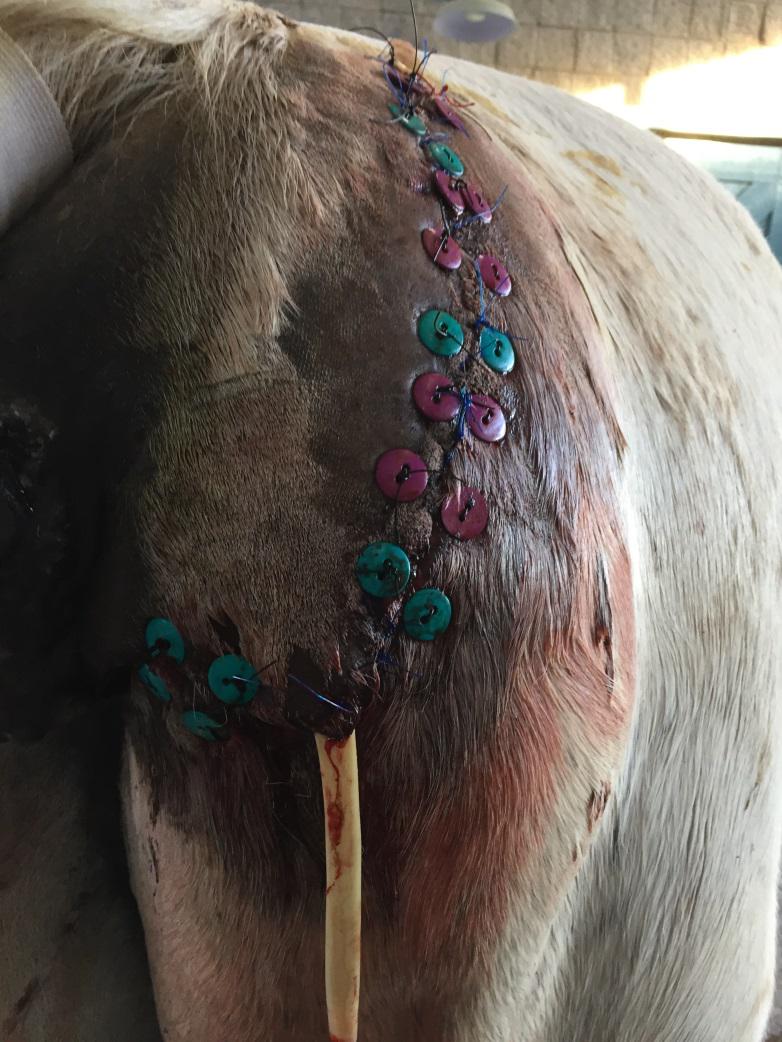
2016-01-31
Managing Lacerations
What do you do if you find your horse with a severe laceration on his leg and blood pooling on the stall floor? The first step is not to panic! Most horse owners might begin to wonder: How do I treat lacerations, and where do I start?
Chances are you will need your veterinarian’s help to manage these serious, hemorrhaging wounds properly. Still, it never hurts to know the steps involved so you can take action while the Arizona Equine practitioner is traveling to your stable or while you are traveling to the equine hospital. If possible, take a picture and email it to azequine@aol.com for guidance.
-
- With any wound, the first priority should be to stop the hemorrhaging. How easy this will be depends on the severity of the laceration. Common ways to slow the bleeding include applying pressure to the affected area with towels or a pressure bandage, which is useful if you need to transport the horse to a clinic. Standing quilts, track bandages, and telfa pads are excellent supplies to have on hand. If the wound is to be repaired via sutures, please do not apply any ointment to the laceration.
-
- Although stopping bleeding is critical, horses do have a lot of blood—about 40 liters (10.5 gallons) for an average 500-kilogram (1,100-pound) horse—and can lose a lot of blood before signs of shock develop, up to 8 to 10 liters,”
-
- Even in the early stages of managing the laceration, watch for lameness or gait abnormalities that could indicate damage to an internal structure.
-
- The Arizona Equine Medical and Surgical Centre veterinarians will perform a physical exam prior to repairing the laceration. For instance, an increased heart or respiratory rate or pale mucous membranes could indicate the horse is in the early stages of shock or suffering from blood loss.
-
- Once our veterinarians have performed an exam, the next step is to sedate the patient. We try to do this before the horse becomes agitated. Sedation enables the veterinarian to examine and treat the wound. Often sterile lube is applied to the wound prior to clipping adjacent hair; this prevents hair from “sticking” in the laceration. The laceration is thoroughly cleaned with a tamed iodine scrub and often flushed with antibiotic sterile water. Once the wound is cleaned, local anesthetic such as lidocaine is injected into the skin and areas around the laceration. If the laceration is on the limb, a nerve block may be utilized prior to cleaning and suturing the wound. Often very large lacerations have a significant amount of tension pulling the skin back together; in this situation buttons are utilized to decrease pressure on the skin.
-
- If possible, the practitioner should ligate (tie or close off) the affected area’s blood vessels to prevent further bleeding. Ligation may not be able to be achieved in the field setting and the horse may need to be transported the Arizona Equine hospital.
-
- Care should be taken to assess the distal (or lower) limb, as the laceration may involve a joint, tendon, tendon sheath, or bone. Very small puncture wounds that appear insignificant can be life-threatening if a deeper structure is involved and becomes infected.
-
- Radiographs (x-rays) may be recommended to ensure that bone is not involved. Even if a fracture or bone chip seems unlikely, the ideal scenario is to confirm the internal structures are intact prior to discharging the horse
-
- The final step is to suture the laceration and if on a limb, apply a bandage.
- Antibiotics and anti-inflammatory (Butazolidin) medication are often dispensed to aid in healing.
Following initial treatment, the patient should be placed on stall rest. Contact Arizona Equine today if your horse has suffered from a laceration.

Sorry, the comment form is closed at this time.